
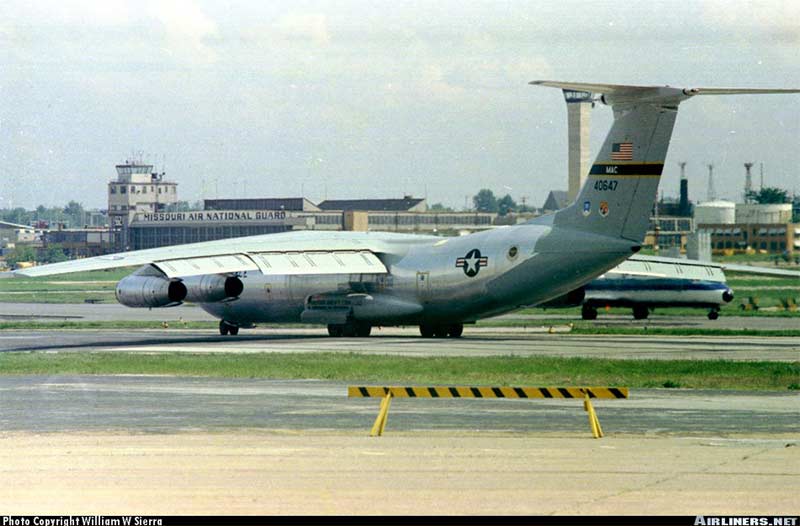
Copyright © - William W Sierra
On St. Patrick's Day, 1973 this aircraft was involved in an incident at McGuire.
Details below, provided by MSgt Edward "Mad Dog" J. Loftus (Retired)
(MADDOGWRI@aol.com).
We were returning from Saigon on 9+ day trip, and we had some problems enroute.
By the time we landed at Dover, unloaded, and refueled we had to accept a crew
duty time extension. We were tired and accepted.
When we called for weather at Mcguire (KWRI) we given temp and winds that
indicated no problems.
But after we had begun the approach we were told that the ground conditions had
dropped to 400 feet and 1/2 mile we continued the approach.
At approximately 120 feet we could not see the runway lights, the windshield
looked like a sheet of frosted glass every time the strobes lite up.
At approximately 110 feet we did not have the runway, so I called for go around
we climbed not knowing that we had clipped the trees.
After we landing, from the opposite end runway, a crew chief came into the
Flight
deck and asked me where we got the trees.
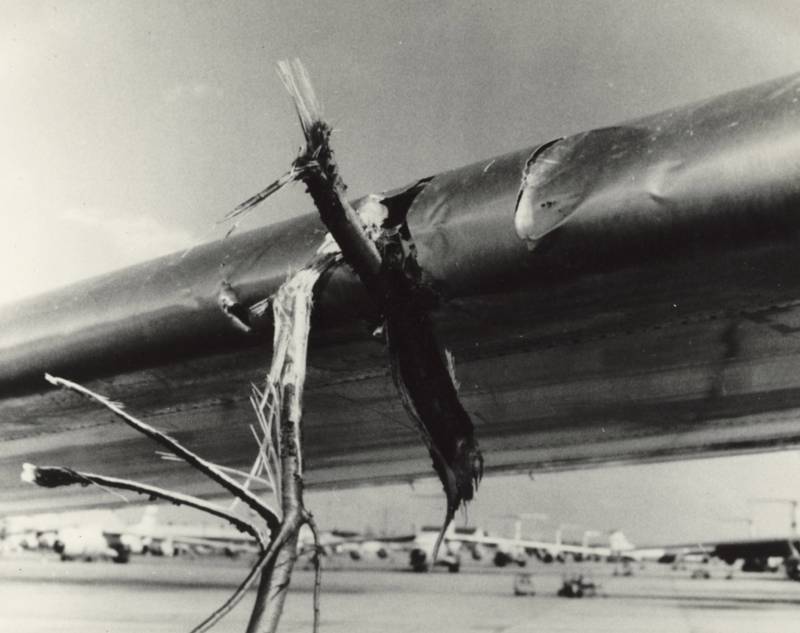
A copy of an official US Air Force photo
The Aircraft is C141A 64-0647, the incident took place on St Patrick's day 1973
Below are photo's I took later that day after I went home I got a Polaroid and
some film.
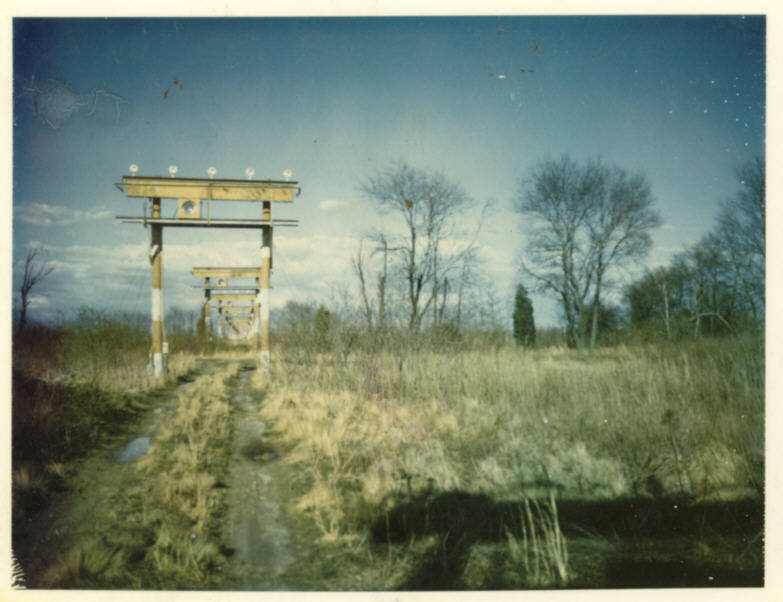
This is a shot towards the runway/path of flight it shows the lights mounted on
telephone poles with a steel cross section, At the time the trees I estimated to
be between 30 and 35 feet in height, the top of the strobes I estimated to be
about 15 to 18 feet, in #1 just below the light bar is the Strobe. I think the
distance to this light post was about 2500 feet
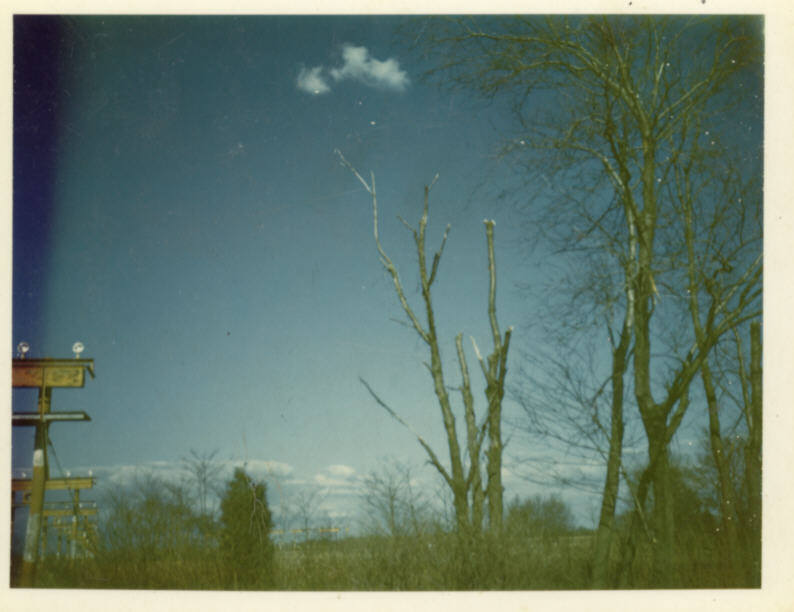
This is at the trees we clipped, They would be at the third section of lights
visible in photo # 1
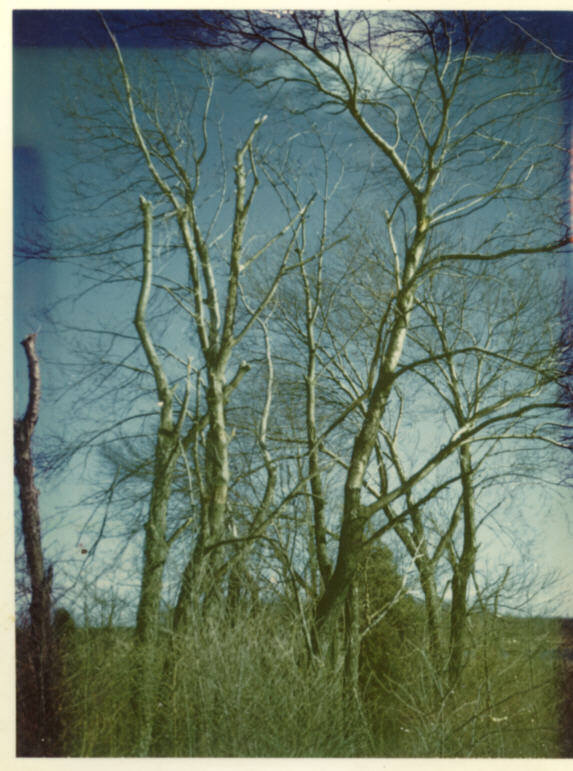
This is perpendicular to the flight path and shows the trees clipped at the top
I estimate the distance from the wing tip to the ground at less than 25 feet as
we were banking trying to slip right an align with the strobes, which from the
flight deck appeared right of windshield
Keep in mind this is from memory 29 years later, I thought I had a copy of my
statement made at the time, but I am unable to find it now.
On 3/24/05 I got the following additional comments from Bill Verno about the 'low approach' described above.
I was the adjacent Crew Chief on 0019 on that particular night.
I spotted the right wing tip of the aircraft as it taxied into position. As she
turned to enter the spot, I could clearly make out a tree imbedded in her
leading
edge and draped over the top of the right wing. I was, to say the least,
astounded at the site .............. to the degree that I questioned what I saw
myself!!!
At it was dark and the taxi and landing lights were on, it more or less blinded
the marshaling Crew Chief's view of the wing. The left wing spotter had no
knowledge as the tree was not in his field of vision. As we started to chock and
pin her, I ran up to 647's Crew Chief and informed him he was in for a busy
night!
After looking at the unbelievable site, he bounded up the crew ladder and into
the cockpit to find out what had happened to "His Plane" ...... I can't be
certain, but I was under the impression that the A/C was a Colonel on this
night.
647 was towed into a hanger bay later on that night and was the talk of the
flight line the following morning!!!
Sgt Bill Verno 438 OMS 1971-1975
Added, December 2008 - From John Attebury:
Having lived through this experience, it is certainly indelibly printed in
my
memory. From the very first, facts began to unfold and make me realize how
close
we had all come to a devastating accident. As an example, no one on the
ground
or in the air had known we even contacted trees for the next two hours
following
a
missed approach, holding and another approach to a landing on the opposite
runway.
We were returning from a trip to South East Asia and approached McGuire,
AFB,
early on St. Patrick's Day, March 17th 1973. We had crew rested at
Elmendorf and
taken an en route diversion to Dover AFB to pick up some helicopter parts
and a
deadheading C-141 crew. I remember on Monday after the accident, the
aircraft
commander of that crew which had been riding in the rear of the aircraft
saw me
on base and asked if we had really done what he had heard about. He was
incredulous. After landing, the deadheading crew had quickly exited the
airplane
out the left crew entrance door and boarded the bus without seeing the
right
wing.
The aircraft commander flying on this mission was our group commander. He
was
strong leader and an experienced pilot, physically active, a man's man who
played
handball several times a week and took on all comers. He was in command!
After
the short trip up from Dover AFB, barely over fifty miles, we were
receiving
vectors for a GCA approach to runway six. The weather forecast had not
changed
from the weather briefing we had received at Dover. We expected a ceiling
five
hundred feet and visibility two miles as I recall. There were thunderstorms
forecast in the area so we were anxious to complete the approach with
minimum
amount of vectoring.
As we settled in on final approach the Precision Approach controller became
a
"broken record" of "on centerline--on glide path." At about 400 feet the
runway
was clearly visible. We continued a normal approach and moments later the
controller suddenly switched from his repetitive on glide slope to
"aircraft-too-low-for-safe-approach-runway-not-in-sight-go-around." At the
same
instant everything in the windshield turned white. I suppose we had the
landing
lights on at that point.
When the aircraft commander hesitated, I took the aircraft, executing a
very
abrupt go-around. I remember thinking that I may have gotten the stick
shaker
during the initial go-around and days later I realized that it could have
been
the trees brushing the ailerons. As we climbed up a few hundred feet, the
aircraft commander looked down, saw the runway and said "There's the
runway,
let's land." "No sir! We're going around." I was not in command but was an
IP
and
did not think he would overrule me. I heard the navigator say something
about,
"I
think we touched down." I thought that was an inappropriate remark as it
might
demean the group commander's flying skills. In reality his altimeter was
right
on
because we later found out we had descended almost to the approach lights.
I had
thought I was looking down at what turned out to be a large light mounted
in the
center of an approach stanchion. In reality, I was probably looking
straight
ahead at that light with the aircraft paralleling the ground at about
twenty
feet
and several hundred feet short of the runway.
We went into holding and were soon joined by a commercial charter flight.
He had
not attempted a landing but was sent straight into holding. After about an
hour
the charter flight landed on the opposite runway. In hind sight I suppose
we
were
shaken by the go around because I remember taking some comfort in the fact
that
an aircraft had landed safely before us.
After parking the aircraft I was in the right seat completing paper work
when
the
scanner tried to talk to me over the long cord on interphone. His voice was
badly
broken and all he could seem to get out was a broken "s-s-sir." I finally
said
"scanner, what's wrong." All that came back was "Sir, you better look out
here
at
the right wing." I slid the chair forward and leaned toward the window.
What I
saw caused the strength to leave my legs. I sat there realizing that the
one
thing that I was not going to do was try to stand up.
After alerting the command post over the radio and requesting flying safety
to
come to the aircraft I finally decided I had the strength back in my legs
and
went out to survey the damage. As luck would have it we were in the spot
closest
to the light poles so we had a clear view of the damage. Another stroke of
luck
was that the wing was receiving an Operational Readiness Inspection and the
MAC
IG team was there to view the show. The wing safety officer was
disappointed in
my statement since I had no idea what had happened and we had considered
the
flight unremarkable until we saw the damage.
That was very early in the morning and the next significant event I
remember was
a visit to the approach control facility the next day. The OIC said that we
could
listen to the tape but that he could not release a copy. I made a personal
recording of the tape as everyone in the squadron was anxious for the
details.
Interestingly I heard tower transmissions that amazed me. Two C-141s had
landed
earlier and I heard the tower on the tape telling them both to "Taxi with
extreme
caution- aircraft not visible from the tower." This made sense as we had
experienced zero visibility prior to the go-around.
Although a full blown accident investigation was conducted by 21st Air
Force,
the
Airlift Wing was able to classify it as an incident based on the cost of
repairs.
Lessons Learned. At that time the Air Force, as well as most other aviation
experts knew very little about Wind Shear. It took the Eastern 66 accident
at
JFK
in 1975 to widen the interest in this phenomena. At that time the
investigation
team knew there was something called wind shear and asked questions which
would
make no sense at this time.
Having all of the information and knowledge at hand today leads to a
somewhat
obvious conclusion. I continued to fly in air transportation and received
extensive training in wind shear until 2003, when I retired from the FAA.
The
approach controller testified that our airspeed on final approach was 195
kts.
He
said he thought we were an F-105 which the Air Guard was flying at McGuire
in
1973. The accident board did not believe that we could have been configured
at
that speed even though the flight data recorder showed the flaps coming
down.
There was zero wind on the surface with a thick fog. Given what could have
been
at least a fifty knot tail wind, the pilot probably had the throttles near
idle
to maintain glide path. I did not have my hand on the throttles so I can
not
verify this theory. However, when the tail wind stopped at low altitude the
aircraft would have sunk dramatically, which it indeed did, after the high
speed
momentum bled off.
It would be wrong not to bring current knowledge of wind shear to this
flight
and
the ensuing investigation. Although the aircraft commander has died, his
flying
skills were called into question. I have a quote below from a wind shear
expert
which would certainly have challenged opinions at the time.
"In 1973 and before, the final cause of many accidents induced by wind
shear
were
labeled as pilot error. For perhaps the first time, the final report of the
Eastern 66 accident stated that the wind shear condition at JFK on that day
exceeded the capability of the aircraft and pilot for any possible
recovery.
Therefore perhaps for the first time in the history of aviation wind shear
was
listed as the cause of the accident vice pilot error."
John Attebury
Added, March, 2017 - From Jerry Carroll:
I was reminiscing about an incident back in the 70's when a C-141 I was
deadheading in back to McGuire AFB as a passenger got so low on approach that it
took
the tops off some (not very tall) New Jersey pine trees. At this point, it seems
almost like a dream in
a way.
Today I was searching around to see if there were any records of the incident,
and I came across the
C141-Heaven site. Amazingly, there I found a recounting of the story.
In those days, I was a C-141 aircraft commander, captain, based at McGuire, and
we had dropped our plane
at Dover and were hitching a ride to get home.
In John Attebury's comments, second paragraph, I am the aircraft commander who
saw him at the base the
Monday following the accident, when I was at the squadron turning in my
paperwork for my own recently
completed Europe trip. And yes, I was incredulous.
During the flight, as I sat in the back with my crew mates (the cockpit was
fully
occupied, as I recall)
I pulled on my headset to listen in on the cockpit chatter. Unfortunately, I
could not hear any outside
radio - only intercom. As I remember, there was very little or no talk, except I
do remember someone
saying 'Go around', and the plane starting to climb. It felt like a very normal
go around.
I didn't feel anything odd, no contact or anything, and nobody sitting with me
did either. No one in the
cockpit expressed any concern or seemed to have any idea we were in any kind of
danger. There was no
conversation about it at all - just routine cockpit talk as we climbed out and
came around for a
(successful) second approach and landing.
After we landed, Ops sent out two crew busses, and, after thanking the crew for
the ride, my crew jumped
onto the first one, parked off the left wing of the aircraft, opposite the wing
with the tree section,
and headed off to our squadron and home. It was late, it was raining, we'd been
gone for a week or more,
we were tired, and we were ready to get home. The next day was a Sunday, and we
could get some rest.
I was astonished when, that following Monday, the first thing I was asked when I
walked into the
squadron was if I had heard about the C-141 that almost bought it.
No indeed, I had not - tell me all about it.
It didn't take me long to realize that that was my flight they were talking
about, and we were all very,
very lucky to be alive!
After reading John Attebury's retelling of the episode, my foremost thought is
'Thank you, John. You
saved my life and every one else's on that plane when you took the controls and
went around. I did not
know that part of the story until I read your comments just now."
Amazingly, the disaster that doesn't happen becomes with the passage of just an
ever fainter memory and
tall tale. I've had a long and great life, and despite having had a few other
close calls during the
course of it, I'm still here. But that particular flight on that miserable night
was no doubt the
closest I've ever come to not being here.
And we didn't even know it!
Jerry Carroll
On 18 September 1979 this aircraft was involved in an incident that resulted in the destruction of the aircraft. It is recounted below.
The aircraft was on a local training mission. After several touch and go's, the
crew noticed that the "Brakes Released" light did not come on after the gear was
extended. The Dash-1, at the time, stated only that the crew should be careful
when applying normal brakes. The crew flew a normal approach and landing. After
touchdown, the spoilers opened only partly then closed. Only #4 Thrust Reverser
would deploy. Normal brakes were inoperative.
The instructor pilot attempted to control the aircraft and directed the copilot
to select Emergency Brakes. The copilot did so and then continued to make
multiple attempts to deploy the spoilers, depleting the #3 Hydraulic System
pressure.
With 4000 feet of runway remaining, the crew heard a loud bang. An electrical
malfunction within the gear handle caused the nose gear to retract. The aircraft
came to a stop 820 feet from the end of the runway and the crew evacuated. Fire
consumed the aircraft.
The actual malfunction was a short circuit within the Landing Gear Handle Relay.
This caused the touchdown relay to stay in the flight mode, and gave the nose
gear an up signal.
Emergency Brakes failed when #3 Hydraulic System lost pressure due to the
copilot's multiple attempts to deploy the spoilers. The thrust reversers did not
deploy because they were locked out by the Touchdown Relay, which was still in
the Flight Mode.
The deployment of the #4 thrust reverser was a malfunction, without which the
aircraft would likely have departed the end of the runway.
The crew escaped without injury, but the aircraft was consumed by fire.
The above information was provided by Paul Hansen
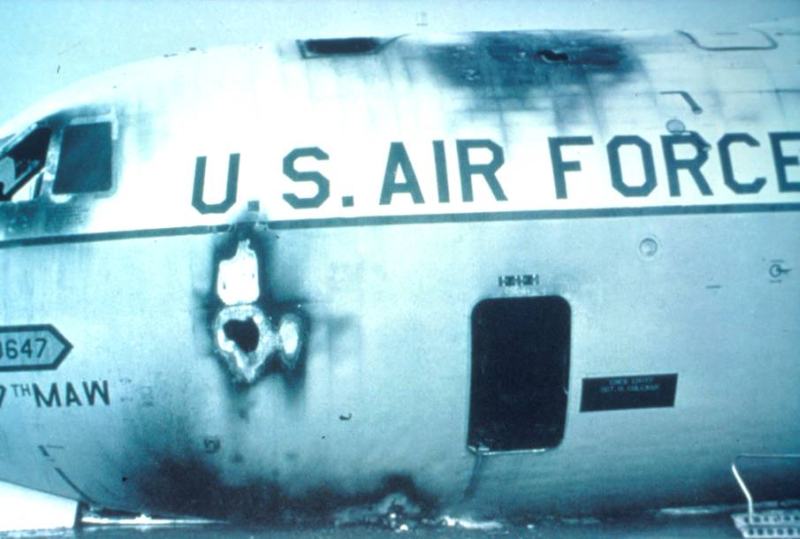
Source:AF Photo
The following are additional USAF photos and a few taken by George Miller. I've
included some notes that George wrote on the back of one of the photos here.
"647
was dismantled and parts returned to the Lockheed factory. The fuselage was sent
to the 78th Military Aerial Port Sqdn at Richards-Gebauer AFB , Missouri (Near
Kansas City) to be used as a loading mockup. The fuselage was cut into sections
and flown by army helicopter to the nearby Charleston water ports, where the
three sections were put aboard trailer trucks. The tail section was dropped (see
photo below for damage) and could not be used for the 78th purposes as the petal
door is needed for a training aid. There are also a few pictures of the wing and
tail on railroad cars before they left the base.
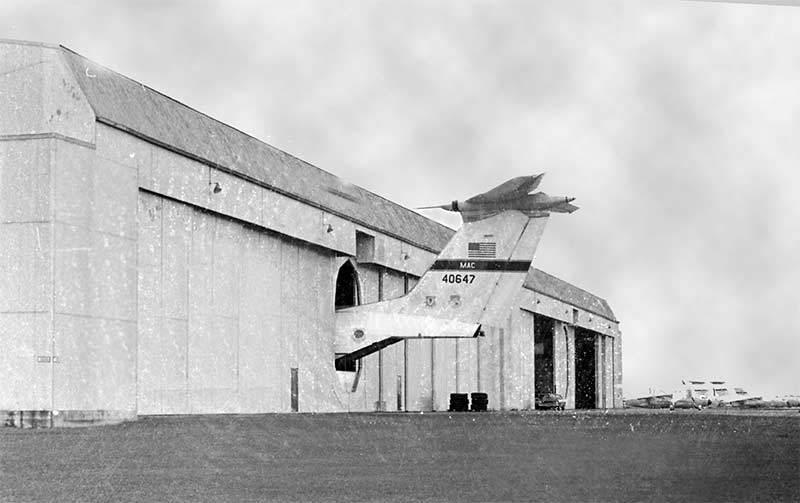
It appears this is in the hanger following the fire.
Probably being stripped of anything useful before being
dismantled. This was a scan of a negative that had a big thumb-print
on it. I couldn't get it to go away so take it for what it is!
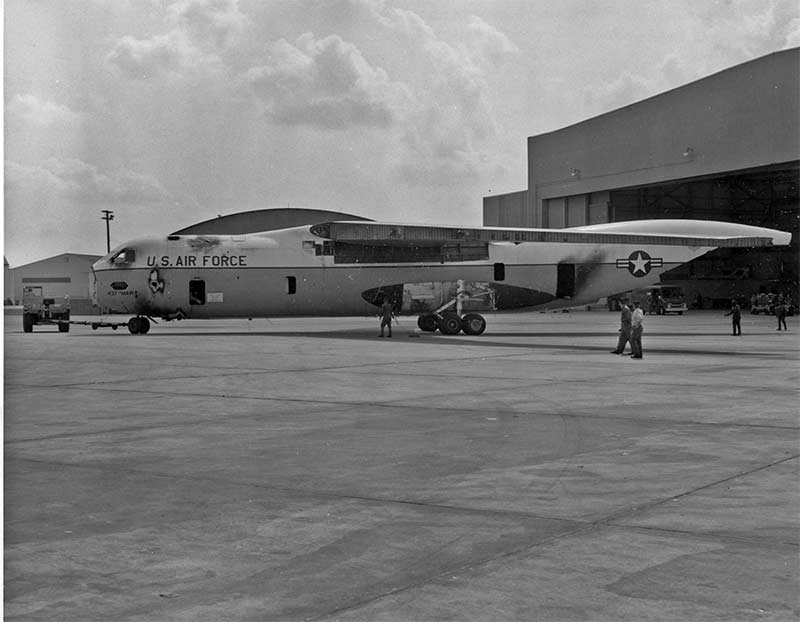
Before it was dismantled into sections.
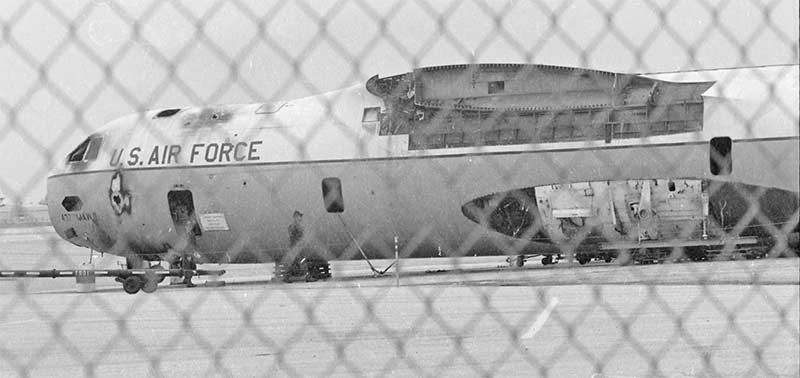
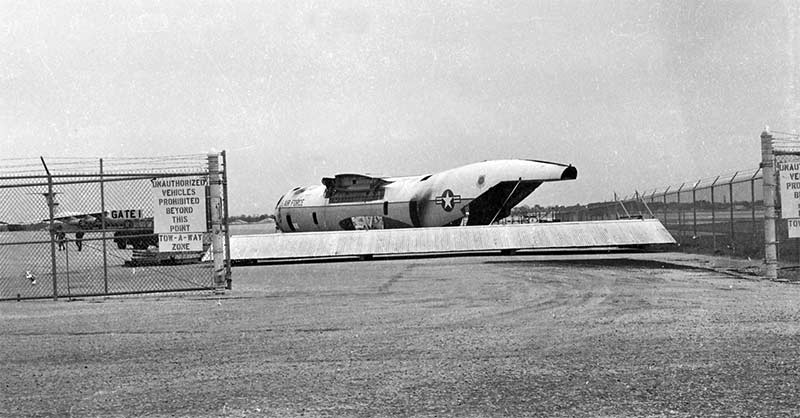
I can't be sure, but I suspect the field to the right of the
fence is where the photo below (of the chopper lifting a part
of the fuselage) was taken.
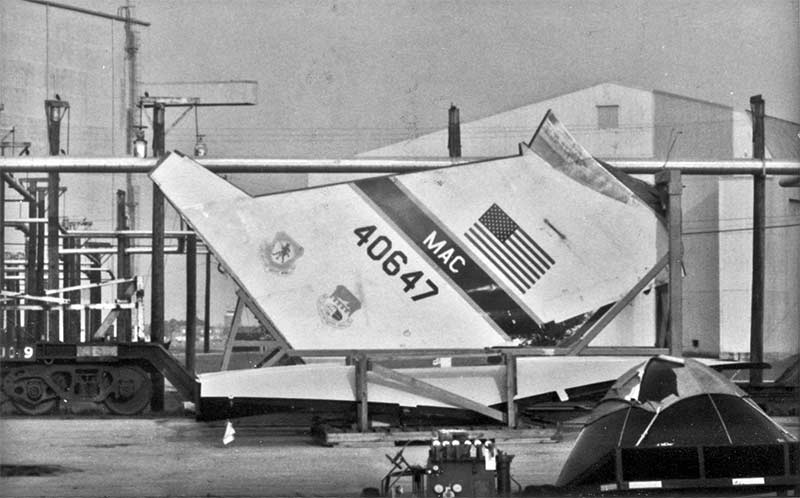
Tail is on a rail-car and ready to go.
Notice the radome in the lower right corner of this photo as well.
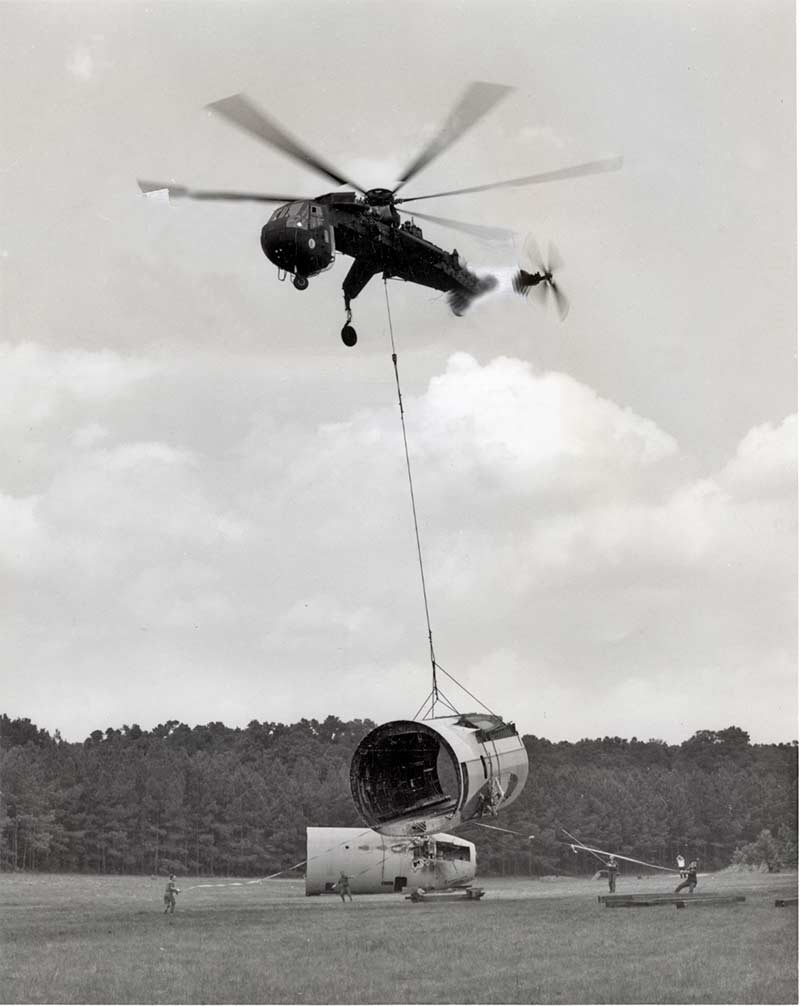
The tail of the chopper in this photo was covered
with a sticky label...it damaged the print.
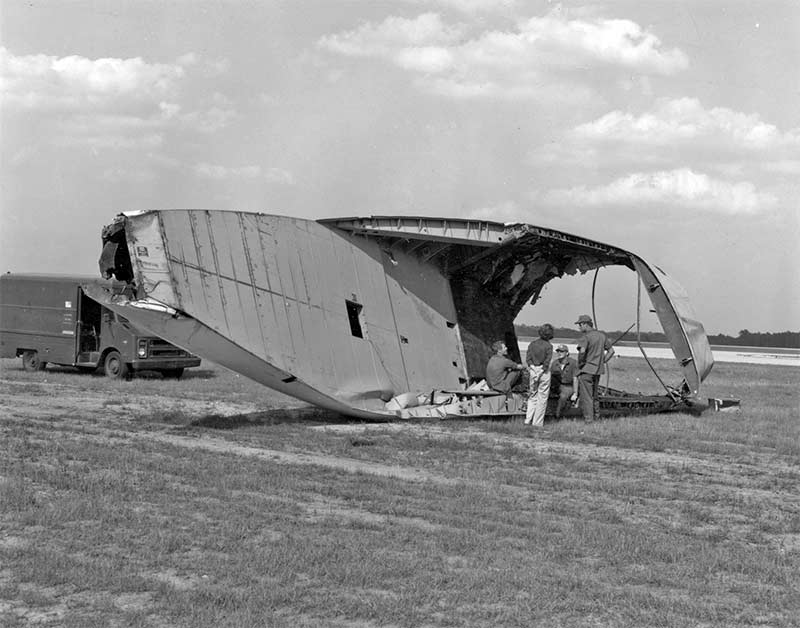
Whoops. This part of the tail was dropped from the chopper.
Too bad we have no photo of THAT!
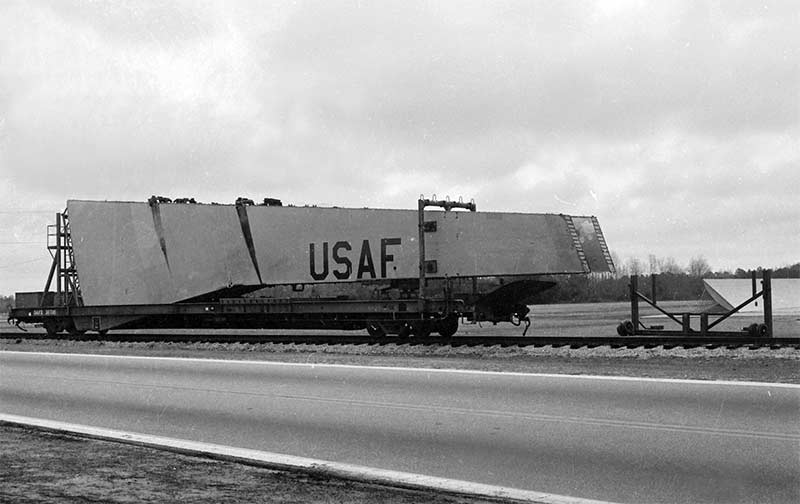
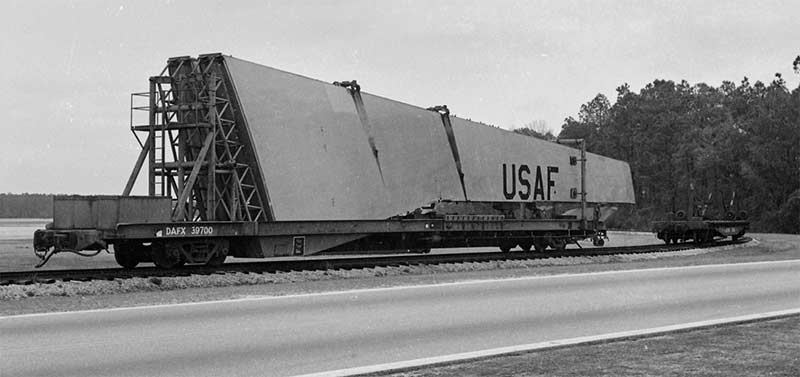
Wings on a rail car, ready to roll.
Notice that the flat-bed car appears to have been modified to
accommodate the wing shape near the front of the car.
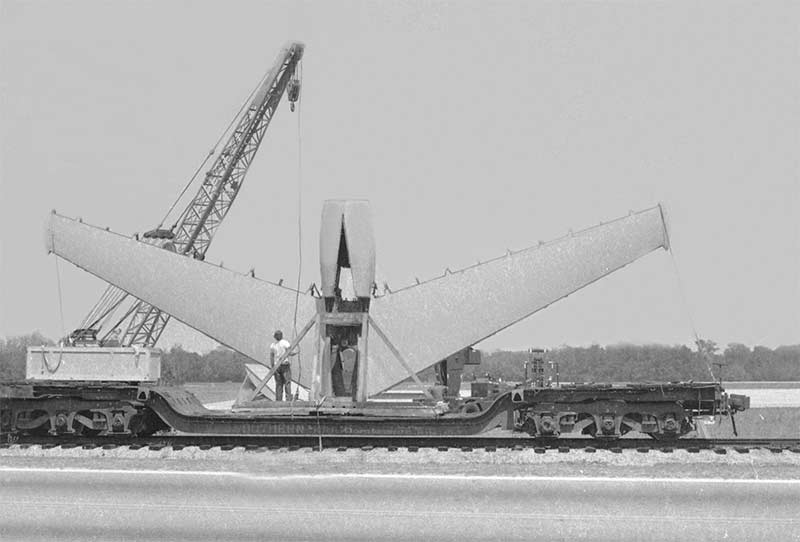
Tail loaded.
In February, 2012, I got a note from Dario Dryden, who works down at the boneyard. He spotted this:
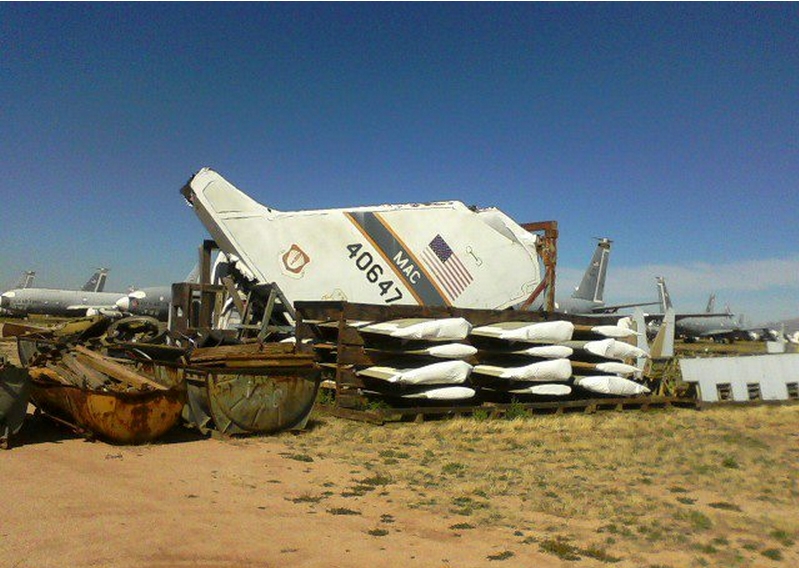
For some reason, it has survived all the of C-141 carnage, though I can't imagine why. Perhaps it's spring cleaning time at DM.